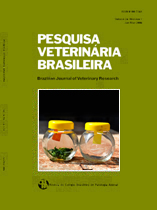 |
|
|
|
Year 2012 - Volume 32, Number 3
|

|
Micobacteriosis by Mycobacterium marinum in Brazilian flounder Paralichthys orbignyanus and barber goby Elacatinus figaro: Histopathological and imunohistochemical diagnosis, 32(3):254-258
|
ABSTRACT.- Romano L.A., Sampaio L.A. & Tesser M.B. 2012. [Micobacteriosis by Mycobacterium marinum in Brazilian flounder Paralichthys orbignyanus and barber goby Elacatinus figaro: Histopathological and imunohistochemical diagnosis.] Micobacteriose por Mycobacterium marinum em linguado Paralichthys orbignyanus e em “barber goby” Elacatinus figaro: diagnóstico histopatológico e imuno-histoquímico. Pesquisa Veterinária Brasileira 32(3):254-258. Laboratório de Imunologia Patologia de Organismos Aquáticos, Instituto de Oceanografia, Universidade Federal do Rio Grande, Av. Itália Km 8, Bairro Carreiros, Rio Grande, RS 96201-900, Brazil. E-mail: dcluis@yahoo.com
Mycobacteriosis affects various species of fish, including those cultured with commercial purposes. It is a chronic systemic with granuloma forming disease known as fish mycobacteriosis. In the last few years the interest of fish culture has been increasing due to the reduction of the natural fish stocks. However the intensification of fish culture has collaborated to the development of diseases such as mycobacteriosis, causing losses due to the chronic characteristics and difficult diagnosis. This study is to report two cases of mycobacteriosis observed at “Laboratório de Piscicultura Estuarina e Marinha of the Universidade Federal do Rio Grande (FURG)”, one for Brazilian flounder Paralichthys orbignyanus and another for barber goby Elacatinus figaro. The Fite-Faraco staining protocol was used. Membranes of mycobacterial cells contain a waxy substance composed of mycolic acids. These are ß-hydroxy carboxylic acids with chain lengths of up to 90 carbon atoms. The property of acid fastness is related to the carbon chain length of the mycolic acid found in any particular species. The fish mycobacterium is much less acid and alcohol fast than the tubercle bacillus and the classic Ziehl-Neelsen Staining Protocol may give false results. The presence of mycobacterial antigen lesions was studied by immunohistological methods using monoclonal antibodies to Mycobacterium marinum. Humans may be infected by these bacteria and develop cutaneous granuloma. In this paper the necessity is stressed for a correct diagnosis of the disease, contributing to the prevention of its establishment in aquatic facilities, and thus, preserving cultured fish as well as human beings from infection. |
| |
|
|
| |
|
 |